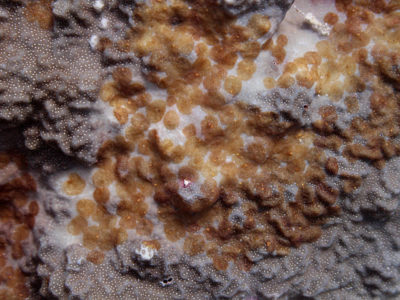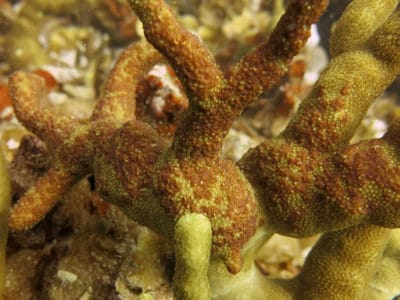Expedition Log: Palau – Day 13
On a previous mission someone had taken a photo of a coral with a strange patchy brownish “discoloration.” When I was asked if I had any idea what was being shown in the picture I said, “Sure, those are acoel flatworms.” It’s not surprising that nobody knew what I was talking about as these tiny creatures are far from popular and well-known reef inhabitants. Since I had copyedited a field guide to tropical Pacific marine invertebrates I knew of their existence after reading about them in the text. I had, however, not seen any photos of acoel flatworms outside of that text nor had I seen them on a dive.
When the scientists started seeing and photographing them on this mission in Palau I kept my eyes peeled hoping to see them during one of the survey dives. It didn’t take long to spot a Porites lobata colony on one of the lagoonal dives that had quite a cluster of them extending over a good portion of the coral’s surface. I took a few photos and noticed that there was a lot of sediment covering the colony (it was a very murky dive with poor visibility). When I moved my hand over the colony to create a little current of water to displace some of the white “dander” from the colony, I found that many of the acoel flatworms were so loosely attached that they blew away along with the sediment. Since that initial sighting I’ve seen them several more times on various species of corals. They seem more common on the calmer and murkier lagoonal sites than on the fore reef.
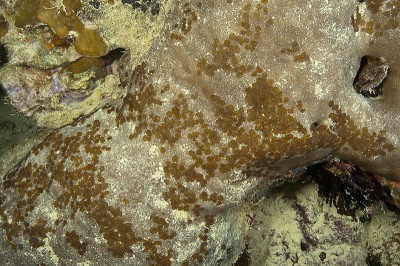
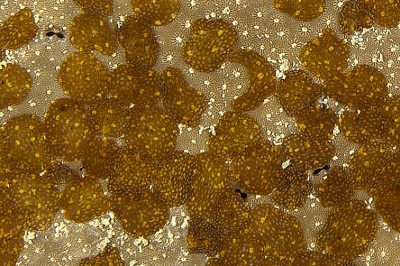
The Porites lobata colony where I first noticed the acoel flatworms (Waminoa sp.) and a detailed view showing the faint whitish spots covering their upper surface (the brighter white spots are the polyp mouths of the coral showing through the translucent acoels).
(Click-thru on images for greater detail.)
Acoel flatworms are interesting, if tiny, occupants of the reef. Traditionally they have been placed in the phylum Platyhelminthes (Flatworms) but recent phylogenetic studies indicate that acoels are more primitive than flatworms being the earliest of the bilaterians (animals which are bilaterally symmetric and have a definite front and back end). Unlike true flatworms, acoels lack a gut cavity. In fact, the name “acoel” is Latin for “no cavity.” A simple mouth located on the underside of the body encompasses any food item where it is then digested directly by specialized tissues. Many taxonomists have placed acoels in their own phylum of Acoelomorpha though others propose different relationships hence their phylogenetic position remains controversial.
It turns out that the acoels we were seeing on corals are known as epizoic acoelomorphs (“epizoic” being Latin for “surface” + “animal”). Many other types of acoels can be found living within sands and sediments and not in direct association with other animals. The available studies suggest that they do not actively injure their coral host though they may passively cause harm—the term “kleptoparasite” describing their association well. The acoels living on the surface of coral colonies seem to feed not on the coral itself but on organic matter trapped in the coral’s mucus layer. This mucus layer is produced by the coral in order to rid the colony of sediments and bacteria as the mucus sloughs off into the water column. By blanketing the coral, the acoels block the coral’s polyps from being able to feed on passing plankton (sometimes ingesting the planktonic items before the coral has access to them). The reason why the acoels we were seeing were brownish in coloration is that, like their coral host, they harbor symbiotic algae which photosynthesize and contribute to the acoel’s nutritional needs. By blocking some of the sunlight that would otherwise reach the coral’s symbiotic algal endosymbionts, the acoels were stealing a meal here as well.
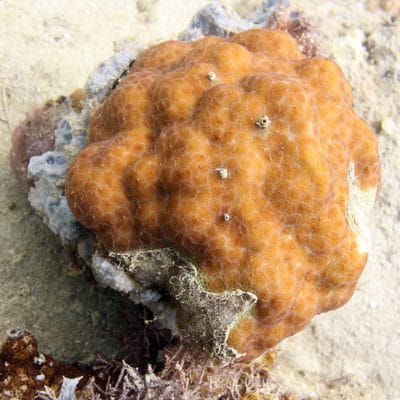
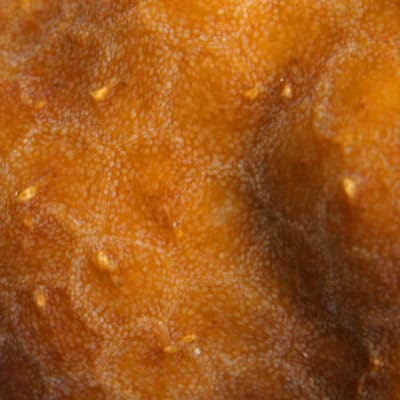
A small Porites colony completely tiled with a mosaic of acoels. While the coral is still alive, being completely coated with a layer of acoels must undoubtedly be detrimental to the coral on which they are living.
(Click-thru on images for greater detail.)
Though there is no evidence of acoels killing corals it seems that a major infestation could not help but be a detriment to the coral’s health. Much of what is known of epizoic acoels seems to come from the aquaculture industry and the aquarium trade where outbreaks of acoels can wreak havoc in tanks. Acoels are simultaneously hermaphroditic and can quickly sexually reproduce to form dense aggregations. They also have the ability to asexually reproduce by splitting in two—a process called “budding”— forming additional individuals. Like many other simple animals, acoels are able to regenerate lost body parts. Though they may be a scourge in an aquarium tank they are an interesting, if often overlooked, members of the complex reef ecosystem.
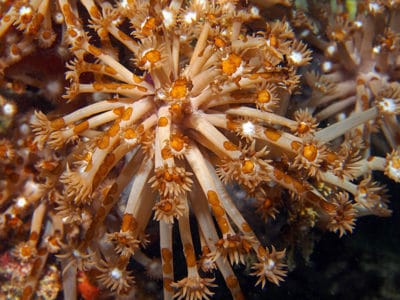
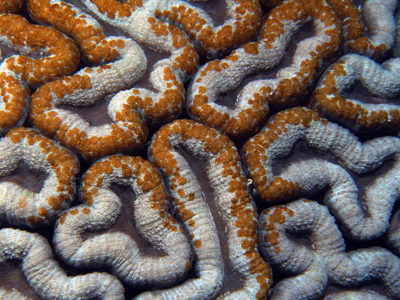
Variety of host species seen in association with acoels: Porites rus, Porites cylindrica, Goniopora sp., Lobophyllia hemprichii.
(Click-thru on images for greater detail.)
Photos: 1-2 Ken Marks, 3-5 Grace Frank, 6 Samantha Clements, 7-8 Andrew Bruckner
